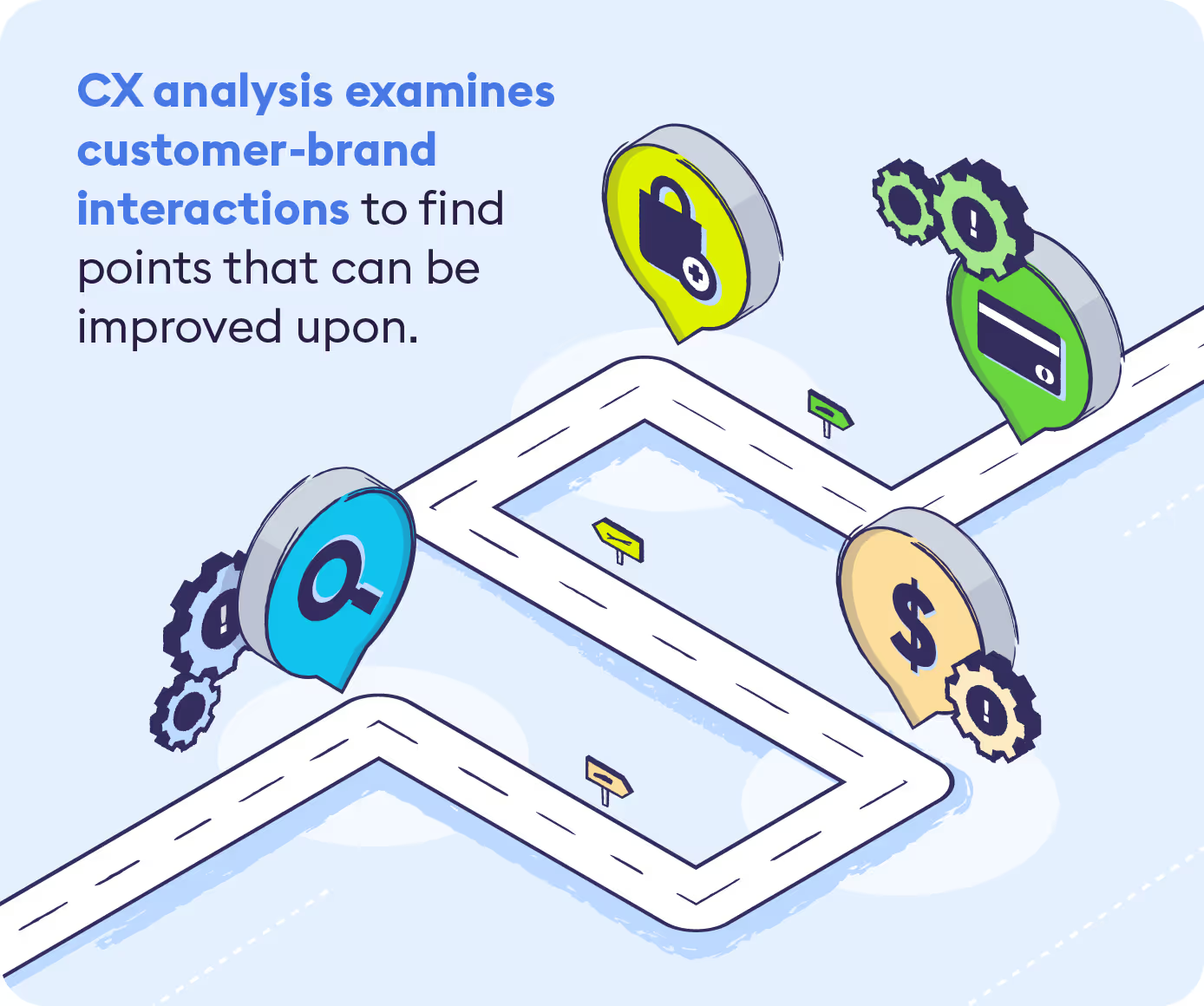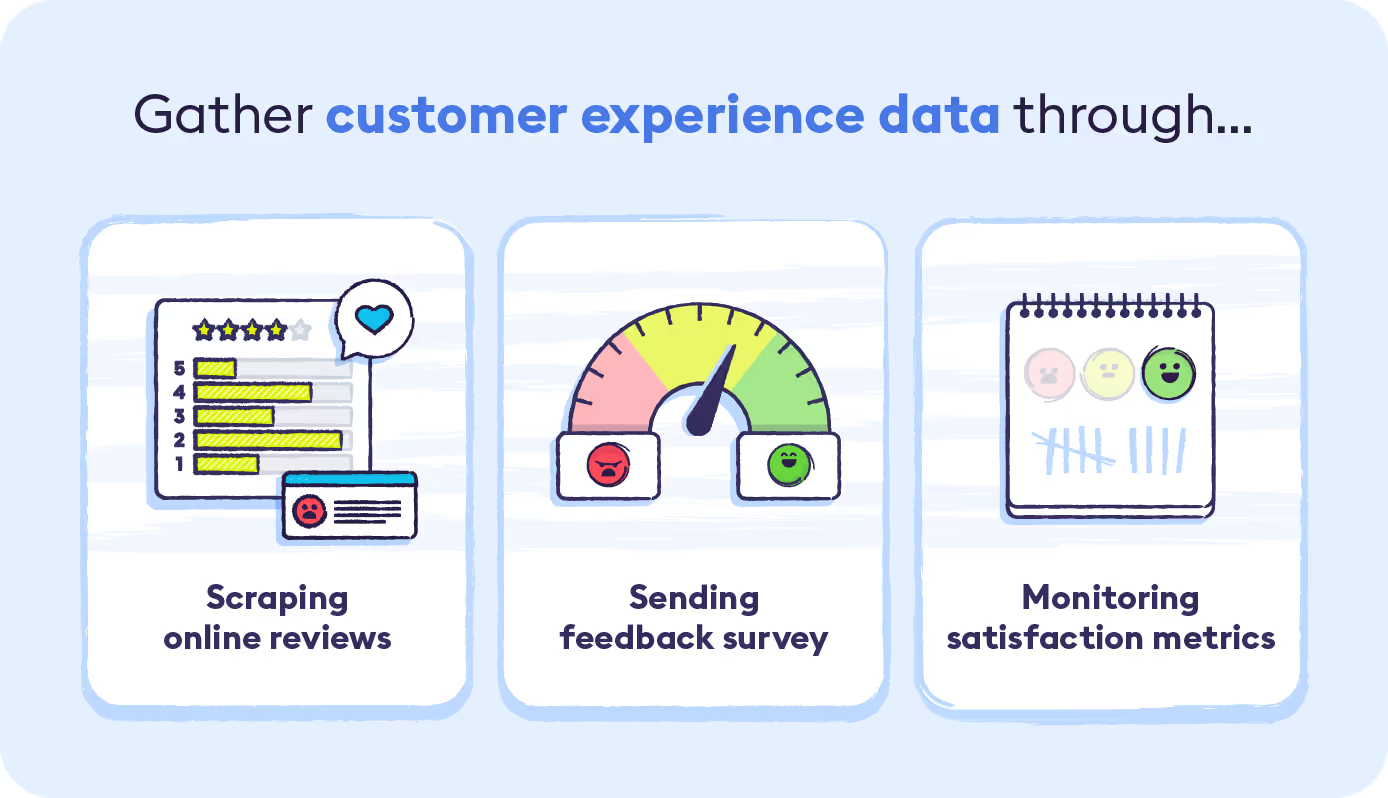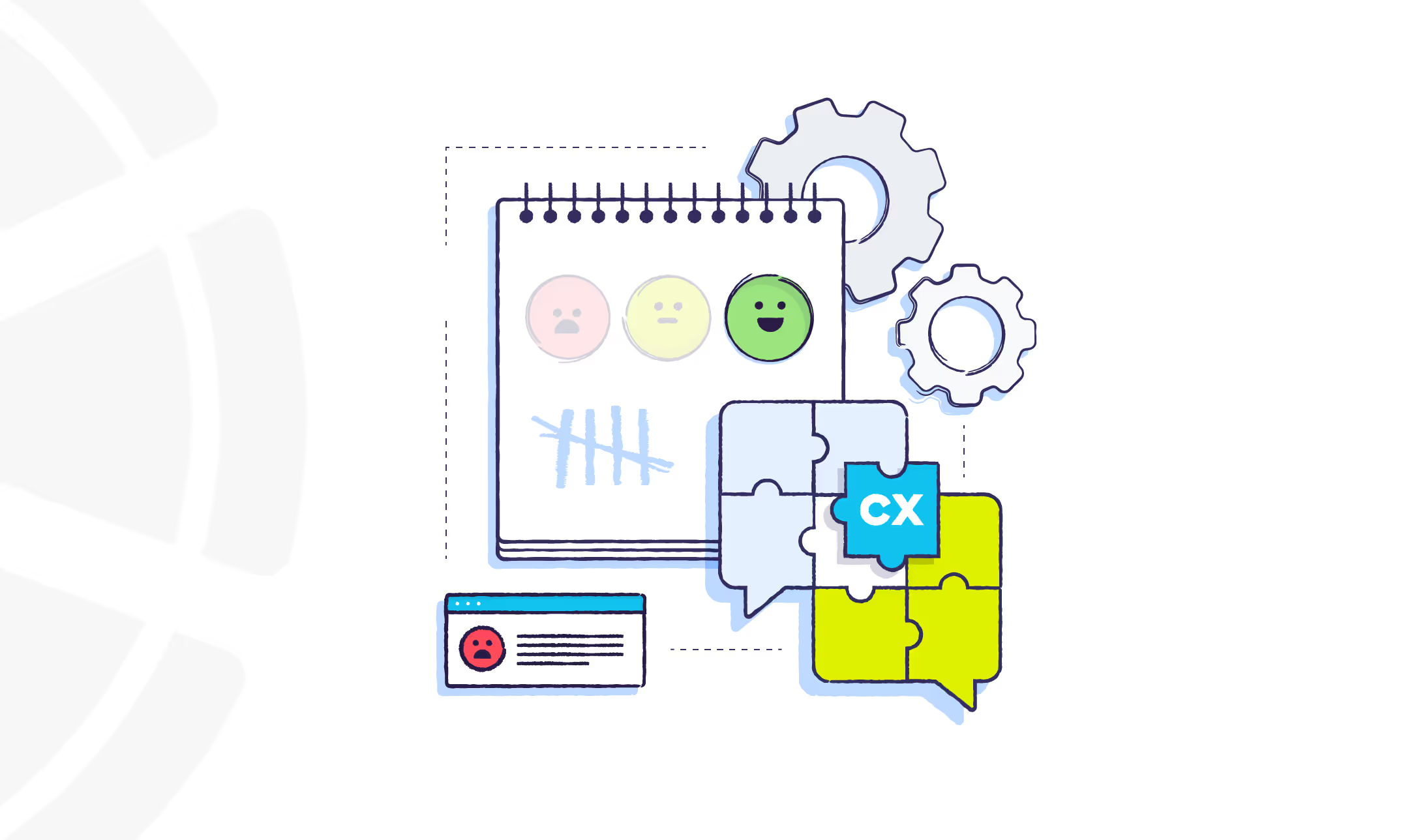Everyone knows that customer experience is important. After all, having happy customers is the cornerstone of any successful business. However, there are so many different metrics, data points, and ways to measure customer experience that it can be overwhelming to know where to start. Below we break down the basic customer experience analysis steps and provide links to more in-depth resources for the complex parts of this process so that you can identify improvement areas for your business.
Summary
Understanding your customer’s journey is the foundation of improving their experience with your brand. Here's a quick breakdown of the steps covered in this guide:
- Choose Key Customer Journey Points
Focus on specific touchpoints like sign-ups, cart abandonments, or service interactions to pinpoint where customers are struggling or succeeding. - Gather Data
Collect feedback through methods like online review scraping, targeted surveys, and customer satisfaction metrics such as NPS to gain actionable insights. - Analyze Feedback to Spot Patterns
Use qualitative tagging, demographic segmentation, and even AI tools to uncover trends, recurring issues, and opportunities for improvement.
By following these steps, you’ll be able to refine interactions across the customer journey and create a seamless experience that delights and retains your audience.
Ready to dive in? Explore the guide for actionable tips and tools to start improving your CX today!
What is Customer Experience Analysis?

Customer experience analysis is a strategy that examines the way customers interact with a brand, and what that interaction is like. It’s usually used to identify areas where brand interactions can be improved, whether it’s direct interactions like targeted ads, customer service calls, or marketing emails, or indirect interactions like online reviews or ratings on social media. You can think of customer experience analysis as trying to answer the question, “How did the customer’s interaction with my brand go, and how can I make it better?” We go into the ways you can gather this type of information in the steps below.
Customer Experience Analysis in 3 Steps
Here are the high-level steps to take when trying to identify where your company can improve their interactions with existing or potential customers.
Step 1: Choose Your Key Customer Journey Points

Customer experience analysis makes more sense when you break it down by specific touchpoints, since one type of interaction might be excelling while another needs work. It’s much more useful and actionable to see exactly where customers are dissatisfied with their experience than to just look at a super high-level overview of CX across your company.
For example, you may notice that customers are frequently abandoning their shopping cart on your e-commerce site, yet convert highly when purchasing through a customer service rep. By gathering data and conducting customer experience analysis and sentiment analysis on your online purchasing process, you may be able to identify why this is happening and what you can do to reduce cart abandonment.
You can approach this first step with a specific customer journey stage in mind as in the example above, or, if you’re not sure where to start, here are some of the most useful touchpoints to analyze:
- New customer sign-up
- Cart abandonment
- Service cancellation
- Contact with customer service
- Chatbot interaction
- New product purchase
- After completing a feedback survey
Now that you know where to look for your data, we’ll get into how to gather the data for customer experience analysis.
Step 2: Gather Data on Those Customer Journey Points

Once you’ve pinpointed where you want to dig deeper into your CX, you can gather data in a variety of ways depending on the specific touchpoint you want to know more about.
Where to find customer experience data to analyze?
Scrape Online Reviews and Social Mentions
To find data on a wide range of topics, one of the best sources is to scrape online mentions. These could be from specific review sites like Yelp or CNET, or from social media recommendations and comments. This type of data is extremely valuable because it’s typically honest, unfiltered, and from customers, for customers. However, it is important to note that online reviews can be biased, as often only the most or least satisfied customers are motivated enough to post them. In order to gather more specific data from a wider swath of customers, most companies rely on feedback surveys.
Send Out Customer Feedback Surveys
These types of surveys allow you to ask your customers targeted questions about interactions they’ve had with your business, allowing you to pinpoint exact problems or successes. For example, if you recently redesigned your site, you could send out a survey to recent conversions asking them what they thought about the new layout. Feedback surveys are not without biases of their own, however, so take a look at our guide on how to properly structure surveys to avoid response bias and gather more accurate data for customer experience analysis.
Monitor Customer Satisfaction Metrics Like NPS
In tandem with online reviews and feedback surveys, you can also monitor your overall customer satisfaction metrics to track high-level changes. These metrics also utilize surveys and can be a good way to quickly gauge the satisfaction level of your audience. A popular metric for companies to track is Net Promoter Score, which measures customer responses to the question “How likely is it that you would recommend [brand] to a friend or colleague?”
Once you’ve gathered the feedback on customer touchpoints, it’s time to start analyzing.
Step 3: Analyze Your Customer Experience Data to Identify Patterns and Trends

The last step in customer experience analysis is to, you guessed it, analyze the data. This is known as customer feedback analytics. The goal is to identify any recurring patterns that indicate a wider selection of your audience is unhappy with something.
Tag and Categorize Qualitative Feedback Data
You should note that most of the data you’ll be gathering will be qualitative, meaning it comes in freeform responses as opposed to quantitative data which is simply a number or rating. Qualitative answers are the best way to get the most meaningful data, but it’s not the easiest thing to analyze at scale. Take a look at our guide on coding qualitative data to learn more about this essential step.
Drill Deeper Using Demographic and Psychographic Segmentation
In order to gain more in-depth insights, you can also drill down deeper into your data by utilizing demographic and psychographic segmentation. Demographics include variables like age, location, and gender, while psychographics encompasses interests and hobbies. By utilizing these additional variables, you’ll be better able to understand which of your customers is dissatisfied with which interactions and tailor your responses to better meet their needs. Survey data analysis is a complex process, but we’ve created a comprehensive guide that you can use to make things easier.
Keep Your Ideal CX in Mind
When deciding how to take action on the insights you’ve gained from your customer experience analysis, keep the following question in mind: “How does my ideal customer experience compare to what my customers are actually saying?” Put yourself in the perspective of your customers by using this data and begin making changes to your business to better create your ideal customer experience.
Customer Experience Analysis and AI
You can speed up the customer experience analysis process enormously by making use of AI analytics tools. Using text analytics, these bots work by automatically pulling online review data and sending out surveys based on customer actions, and then analyzing the freeform responses into overall trends and themes.
AI-backed software can even provide more in-depth insights than manual categorization by making use of sentiment and intent tracking. Learn more about AI analysis capabilities in our guide to text analytics.
Try for yourself and write a sample review in the text editor!
If you’re looking to take control of your customer experience analysis efforts by tracking feedback at scale, see what Chattermill’s software can do for you by signing up for a demo. Additionally, we've compiled some customer experience quotes from industry experts to help tailor your CX strategy even further.
Customer Experience Analysis: FAQs
What is customer experience analysis?
Customer experience analysis is the process of examining customer interactions, feedback, and behaviors to understand how people perceive and engage with a brand across touchpoints.
Why is customer experience analysis important?
It helps businesses identify strengths, uncover pain points, and improve customer journeys. By acting on insights, companies can boost satisfaction, loyalty, and long-term growth.
What data is used in customer experience analysis?
Data sources include surveys, Net Promoter Score (NPS), Customer Satisfaction Score (CSAT), Customer Effort Score (CES), reviews, support interactions, and behavioral data such as website activity or purchase history.
How is customer experience analysis conducted?
The process involves collecting feedback, categorizing insights, identifying trends, and linking findings to customer outcomes. Many businesses use analytics platforms and AI to process large datasets efficiently.
How does customer experience analysis improve business performance?
It reveals opportunities to remove friction, personalize interactions, and enhance service quality. These improvements lead to higher retention, stronger brand loyalty, and increased revenue.
What tools are used for customer experience analysis?
Tools often include feedback analytics platforms, CRM systems, journey mapping software, and AI-driven sentiment analysis solutions that detect patterns in unstructured data.
What challenges do companies face in customer experience analysis?
Challenges include managing data from multiple sources, analyzing unstructured feedback, and ensuring insights are shared across departments for meaningful action.
How often should businesses conduct customer experience analysis?
Analysis should be ongoing, with regular tracking after key touchpoints and periodic deep dives to identify long-term trends and guide strategy.















